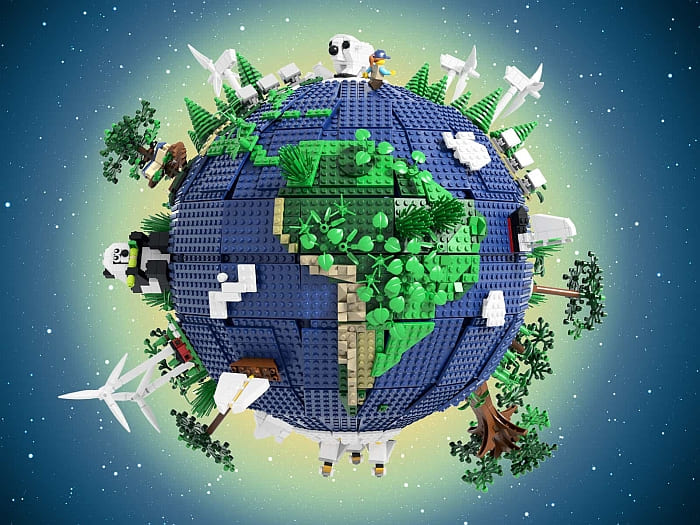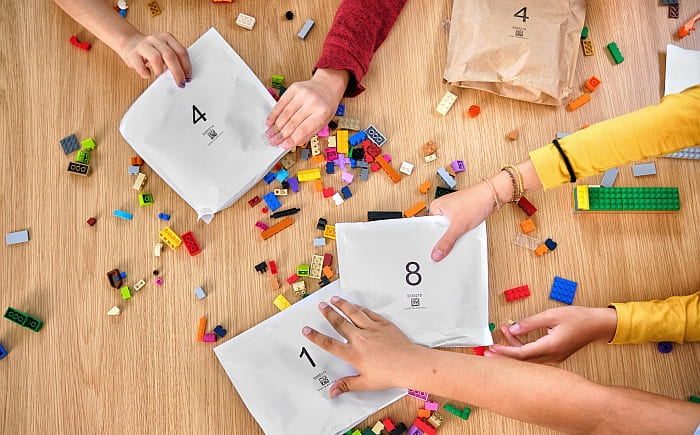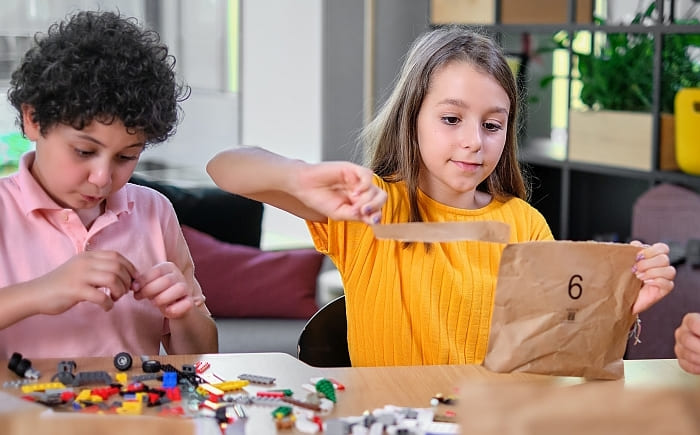Today, the LEGO Group announced that they are investing up to $400 million over a three years period to accelerate sustainability efforts. The next step is to begin to phase out single-use plastic bags from LEGO boxes in the latest move to make all packaging sustainable by 2025. Further investments will also be made to create more sustainable products, achieve zero waste and carbon neutral operations, and to inspire children to learn about sustainability through play. Below is the full press-release with further information.

The LEGO Group today announced it plans to invest up to $400 million – covering ongoing costs and long-term investments – across three years to accelerate sustainability and social responsibility initiatives. The company, which has made a series of moves over the past 10 years to build a better planet for future generations, believes it is increasingly urgent and important to priorities environmental and social activity.

The LEGO Group CEO, Niels B. Christiansen said: “We cannot lose sight of the fundamental challenges facing future generations. It’s critical we take urgent action now to care for the planet and future generations. As a company who looks to children as our role models, we are inspired by the millions of kids who have called for more urgent action on climate change. We believe they should have access to opportunities to develop the skills necessary to create a sustainable future. We will step up our efforts to use our resources, networks, expertise, and platforms to make a positive difference.”
As a next step, the company will begin to phase out single-use plastic bags used in LEGO boxes to package the loose bricks. This is part of its ambition to make all its packaging sustainable by the end of 2025. From 2021, Forest Stewardship Council-certified recyclable paper bags will be trialed in boxes.

Christiansen said: “We have received many letters from children about the environment asking us to remove single-use plastic packaging. We have been exploring alternatives for some time and the passion and ideas from children inspired us to begin to make the change.”
Moving away from the existing packaging is not a simple task and will take time, as new material must be durable, lightweight and enhance the building experience. Several prototypes made from a range of different sustainable materials have so far been tested with hundreds of parents and children. Children liked the paper bags being trialed in 2021 as they were environmentally friendly and easy to open.

In addition to developing and implementing sustainable materials, the up to $400 million investment will also focus on a range of social and environmentally focused actions to inspire children through learning through play, making the business more circular, and achieving carbon neutral operations. The activity will drive meaningful, long-term change aligned to two United Nations Sustainable Development Goals: #4 Quality Education. and #12 Responsible Consumption and Production:
CHILDREN
By 2022, the LEGO Group aims to reach 8 million children around the world annually with learning through play through a range of activities with partners, in collaboration with the LEGO Foundation. It will build on its work with organizations such as UNICEF, Save the Children, and local partners to scale up programs that give children-in-need access to play and opportunities to develop life-long skills such as problem solving, collaboration, and communication. In 2019, 1.8 million children were reached through such programs. 25% of profits from the LEGO Group go to funding the LEGO Foundation’s projects, activities, and partnerships.
CIRCULARITY
The LEGO System in Play inspires endless play possibilities that support the principles of circular design – a product made of quality materials that can be used and reused. The quality, durability, safety, and consistency of LEGO bricks mean they can be passed from generation to generation. Bricks made today, fit those made more than 40 years ago.
Programs will be put in place to encourage people to donate their pre-loved bricks to children in need of play. LEGO Replay, which was successfully trialed in the United States in 2019, will be rolled out in two additional countries by the end of 2022. So far, LEGO Replay has donated bricks to over 23,000 children across the United States.
SUSTAINABLE MATERIALS
Work will continue on the company’s Sustainable Materials Program, which employs more than 150 experts, to create sustainable products and packaging. In 2015, the Group set a target to make its products from sustainable materials by 2030. It will expand its use of bio-bricks, such as those made from sugar cane, which currently account for almost 2% of its element portfolio.
It will continue research into new, more sustainable plastics from renewable and recycled sources, and join forces with research institutes and other companies – especially those developing new recycling and bio-based material production technologies – to find materials that are as durable and high quality as those used today.
The planned investments include both costs associated with the development of new sustainable materials and the investments in manufacturing equipment.
ZERO WASTE & CARBON NEUTRAL OPERATIONS
The LEGO Group’s manufacturing operations will be carbon neutral by 2022. To achieve this, additional solar panels will be installed on all its factories, and onsite capacity will be supplemented with the procurement of renewable energy. Further investments will be made to improve energy usage, for example by installing new systems that use ambient air in cooling processes during LEGO brick production.
Improved waste handling and reduction in water consumption will further reduce the LEGO Group’s operational impact on the environment. No waste will be diverted to landfill by 2025 and water use will drop by 10% by 2022.
The LEGO Group will continue to work with organizations such as the Ellen MacArthur Foundation, World Wild Fund for Nature, RE100, UNICEF, and Save the Children in order to create the greatest impact.
Christiansen said: “At a time when the world is facing numerous challenges, companies must take action to create a lasting positive impact on the environment and society. No one can do it alone. I urge companies, governments, parents, children, and NGOs to continue to join forces to create a sustainable future for our children, the builders of tomorrow.”
Speaking about the letters the company receives about sustainability from children, Vice President, Environmental Sustainability, Tim Brooks said: “Children share the most fantastic and creative ideas about how we can be more environmentally friendly when they contact us. We respond to every letter and many are shared with the CEO and Environmental Responsibility team for further consideration. I love hearing from children. It’s the best part of my job!”
If you know a child that has an idea to help shape the LEGO Group’s sustainability ambitions, visit LEGO.com/service to share it with Tim and the team.
What do you think? How do you like LEGO’s sustainability goals? And what do you think of the paper bags for LEGO parts? Feel free to share your thoughts and discuss in the comment section below!
And you might also like to check out the following related posts:












Okay, I appreciate that paper is easier to recycle, but as a customizer, I want to see what’s inside each bag.
Those clear bags are such an annoyance, so this is a welcome change. But I agree with Peter that we need something to visualize what’s inside the bag. Maybe print a parts list on them? Or put the parts list at the end of the instrucions by bag?
When I was a kiddo growing up in the 70’s Lego, in at least some sets, had the pieces in boxes lined with styrofoam, a clear layer of plastic to see the pieces and a cardboard flap to see inside. A true horror to modern environmentalists! 😉 What I find interesting is that in the early 90’s we moved from paper to plastic to save the trees and now with Lego packaging they’re moving from plastic to paper to save the environment. I have this image in the future of no bags whatsoever, just all parts put into the boxes and you download the instructions to display on your PC or smart phone. No bags… That would have been a nightmare with UCS Star Destroyer! 😀
The paper bags are likely going to be thicker than plastic, which means the boxes will have to be bigger. So you gain on one front but loose on the other. Also, I hope they are talking about recycled paper and not cutting down more trees.
They should have made the bags reusable with a ziptop so they can double for storage. This was the biggest problem with the plastic bags too. If they would have made them reusable, they would be much more environmentally friendly.
Thank you, Lego for yet again focusing on the importance of taking care of our environment. The bags may or may not be thicker and or whether or not the boxes will be little bit bigger. It doesn’t matter because we’re always going to have something that we need to recycle in this world. That’s just the way things are. Plastic however is much harder to recycle and particularly the flimsy plastic that they use to hold the parts and pieces in the Lego bags. It seems to me that the more damaging in our environment is plastic. The fact that Lego is focusing on the environment is a step further than most companies would ever make. I hope that changes soon. There are other companies like Amazon are taking steps to help our environment too. I’m hoping it’s a growing trend around the world.
Well, I guess it’s some sort of corporation greenwashing, but still… Paper and cardboard should be a lot easier to recycle than plastic, anyway…
And if they don’t get recycled, they’ll still decompose over a few months instead of taking 10,000 years.
It’s good to see they are paying attention to these matters. Although some of it may be preventative survival strategies. They want to be known as the good guys. I’m not blaming them at all, by the way. It’s a good strategy and good for the environment.
Good choice. It should also be easier to dump out all the parts without the smallest ones getting stuck in the plastic and accidentally thrown away.
I did this last night – I was putting together Luke’s speeder, and one of the clear glide pieces (no idea what they’re called) got stuck in the corner of the bag, which I then gave to the cat to play with. When I finally got to that part in the directions half an hour later, the cat had run off with the bag and I had to dig under the couch to find it. Sure enough, it was still in it!
Hehe, although clear pieces could easily get lost, anyhow… Especially with cats around…
This should also cut down on theft. You know, when people steal bags with the most valuable parts then reseal the box and return it to the store.